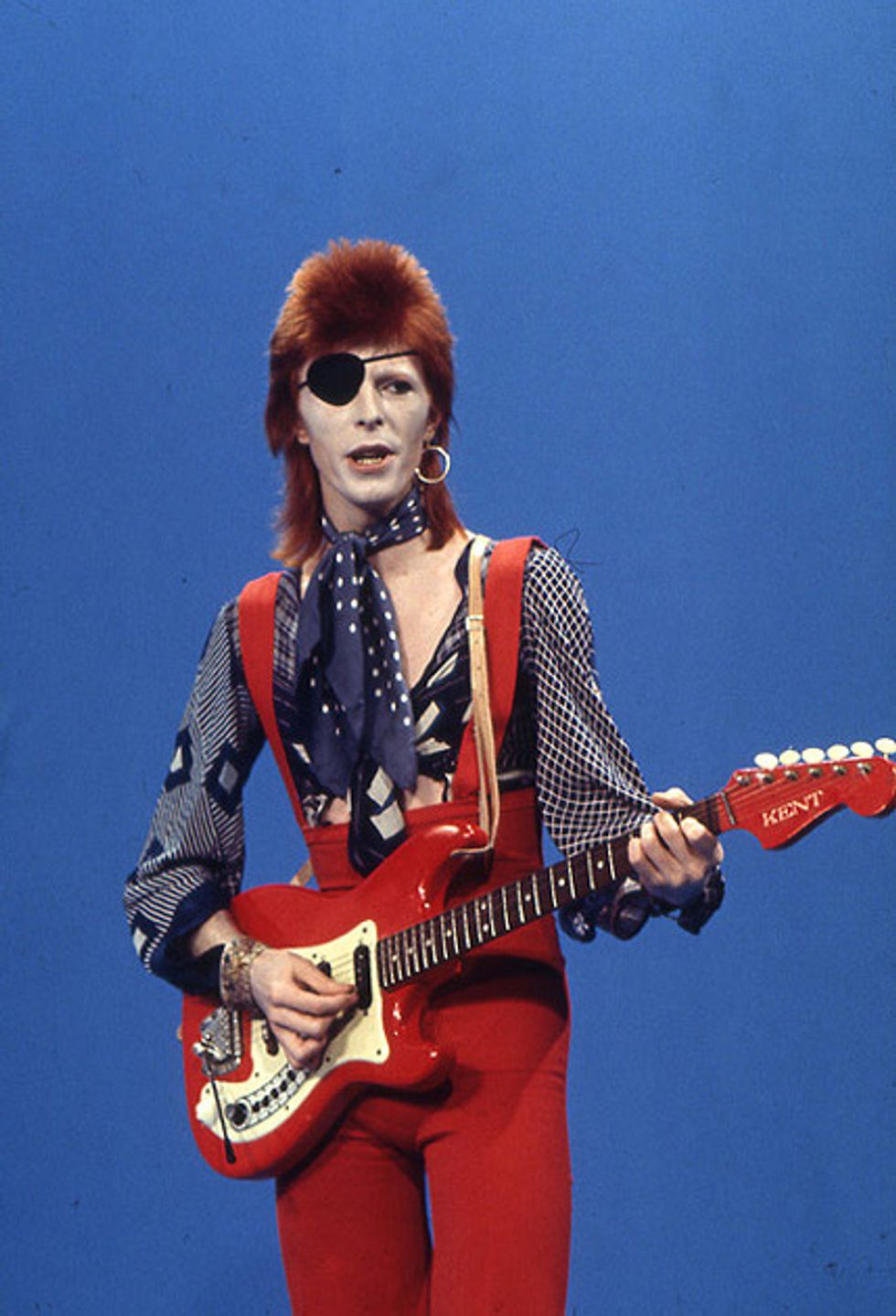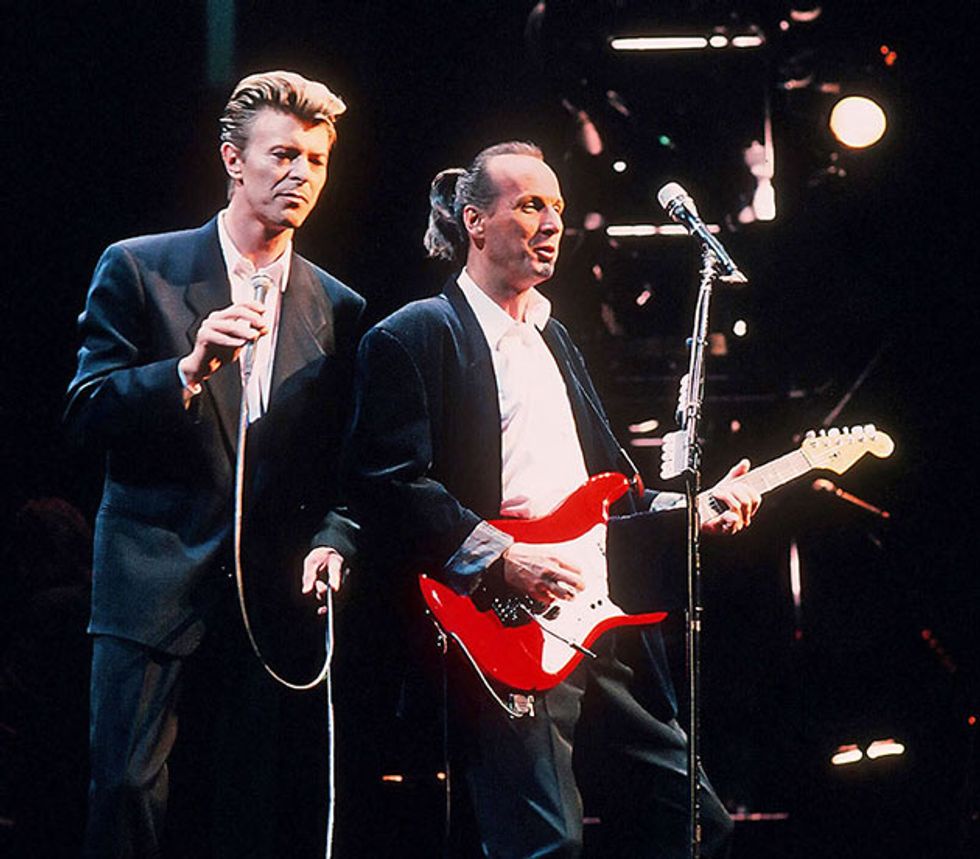The world has lost one of its foremost champions of unique guitar work. David Bowie died January 10, 2016, at age 69, two days after releasing an album, Blackstar, that seemed like the beginning of yet another of his famed creative rebirths. Unbeknownst to most, Bowie had reportedly been in the grip of cancer for 18 months and, in retrospect, the music and videos for Blackstar—with their introspective, spiritual, and death-reflective themes—now seem as if the artist knowingly created them as his own requiem. Beyond their stark, profound, epic beauty on a purely musical level, they are not only evidence that Bowie was a restless, boundary-pushing creator even as he looked death in the eye, but they’re also a reminder of his invaluable contributions to 6-string greatness.
Bowie emerged from the English folk-rock scene of the 1960s to become one of the most inventive and eclectic artists of the classic rock era—and beyond. His innovative recordings with producer Brian Eno helped expose the 6-string genius of guitarists Robert Fripp and Adrian Belew to wider audiences on albums such as Low (1977), Heroes (1977), and Lodger (1979), which became the foundation for ambient sounds and studio effects in rock, laying the groundwork for such diverse bands as U2, Radiohead, and Sigur Rós. But even before that he’d helped establish the glam scene and set a bar for rock theatrics with his elaborate, transformative costuming and stage delivery, starting with his third studio album, 1970’s The Man Who Sold the World.
the work I’ve done.”
That influential album also ignited his career-long habit of championing and collaborating with exceptional guitar players—a roster that starts with Mick Ronson and continues through Earl Slick (who debuted with Bowie on 1974’s Diamond Dogs), Carlos Alomar (1975’s Young Americans), Stevie Ray Vaughan (1983’s Let’s Dance), Reeves Gabrels (1989’s Tin Machine), and now Blackstar guitarist Ben Monder. The list also includes guitarists who were already well established when they first began working with Bowie: King Crimson’s Fripp, Peter Frampton (who performed on 1987’s Never Let Me Down), Nile Rodgers (who produced and played on 1993’s Black Tie White Noise), and David Torn, who played on the three albums before Blackstar, starting with 2002’s Heathen.
Each guitarist was seemingly chosen according to the musical approaches Bowie was interested in exploring at the time. Ronson, with his big Les Paul/Marshall tone and rocking persona, fulfilled Bowie’s interest in becoming writ large on record and onstage. Fripp, Belew, Gabrels, and Torn all seemed selected to help him explore new sonic and conceptual dimensions. Rodgers, Slick, Alomar, and Vaughan were drafted as fellow travelers down various American musical roads. Frampton and Bowie were schoolmates and near-lifelong friends.
David Bowie onstage with Adrian Belew for the Sound + Vision Tour in 1990 at the Palace of Auburn Hills in Michigan. Bowie had a longstanding musical relationship with Belew, dating back to Bowie’s Heroes tour in 1978.
Photo by Ken Settle
But the initial explosion in the career of Bowie, who was born David Jones in London’s Brixton district, coincided with the release of The Man Who Sold the World and the unveiling of his costumed, cosmetic’d, sexually ambiguous persona of Ziggy Stardust. Ziggy became the first of Bowie’s many stage identities, which went on to include the dapper “Thin White Duke” of his Young Americans (1975) and Station to Station (1976) era, the expressionist Pierrot of Scary Monsters (And Super Creeps) (1980), the punk-Gothic futurist of Outside (1995) and Earthling (1997), and, finally, the dapper, designer-suited rock ’n’ roll éminence grise of the past 15 years.
Along the way Bowie acted in films, most notably The Man Who Fell to Earth (1976), The Hunger (1983), and Labyrinth (1986). He also appeared on Broadway in the title role of The Elephant Man, and co-wrote the script and supplied the songs for the new Lazarus, which is currently enjoying an off-Broadway run at the New York Theater Workshop. Thanks to his flair for the visual and his interest in all art forms, Bowie cultivated a reputation in the fashion and arts worlds as well. He is the subject of a touring multi-media art exhibition called David Bowie Is, which debuted in 2013 and has made museum stops at major cities around the world including New York and Chicago.
YouTube It
In retrospect, this video for “Lazarus,” a song that appears on Bowie’s just-released album, Blackstar, and in his current stage production, “Lazarus,” seems a harrowing vision of his own impending death. Bowie plays some guitar on the song, which also features the dark, gorgeous performance of the jazz ensemble he assembled for the sessions, including guitarist Ben Monder and bassist Tim Lefebvre.
Bowie remarked on his creative flexibility when I spoke with him in 1999 about his collaborations with Gabrels, who co-produced Earthling and co-wrote more than 70 songs with Bowie. “I think it’s a matter of having a natural eclecticism,” he said. “Reeves can be happy and prolific playing anything from jug-band music to working in a very avant-garde form. I work in a similar way. I do not feel any genre loyalty. I work in a combination of musical styles—a kind of hybrid. That has really been the essence of all the work I’ve done. It’s my natural element.”
















![Rig Rundown: Russian Circles’ Mike Sullivan [2025]](https://www.premierguitar.com/media-library/youtube.jpg?id=62303631&width=1245&height=700&quality=70&coordinates=0%2C0%2C0%2C0)
















![Rig Rundown: AFI [2025]](https://www.premierguitar.com/media-library/youtube.jpg?id=62064741&width=1245&height=700&quality=70&coordinates=0%2C0%2C0%2C0)




















 Zach loves his Sovtek Mig 60 head, which he plays through a cab he built himself at a pipe-organ shop in Denver. Every glue joint is lined with thin leather for maximum air tightness, and it’s stocked with Celestion G12M Greenback speakers.
Zach loves his Sovtek Mig 60 head, which he plays through a cab he built himself at a pipe-organ shop in Denver. Every glue joint is lined with thin leather for maximum air tightness, and it’s stocked with Celestion G12M Greenback speakers.






